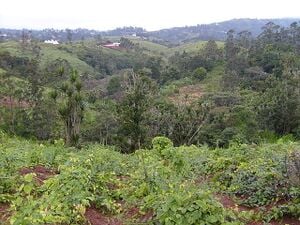
 Farming support to communities living near wildlife reserve in Cameroon lowers rates of hunting, news.mongabay.com (Dec 19, 2023)
Farming support to communities living near wildlife reserve in Cameroon lowers rates of hunting, news.mongabay.com (Dec 19, 2023)  The Ancient ‘Wonder Material’ Sucking CO2 Out of the Atmosphere, reasonstobecheerful.world (May 22, 2023)
The Ancient ‘Wonder Material’ Sucking CO2 Out of the Atmosphere, reasonstobecheerful.world (May 22, 2023)
Networks and sustainability initiatives[edit | edit source]
- Centre for Community Regeneration and Development
- Community Action for Development
- Connected Youth of Cameroon
- Green Cameroon
Food activism[edit | edit source]
- Better World Cameroon, Permaculture the African Way
- Cameroon Sustainable Sun Bakeries Program
Social inclusion[edit | edit source]
Sustain Cameroon on facebook
News and comment[edit | edit source]
2021
'A quiet conservation success story, the likes of which aren't told enough', Feb 26, 2021[1]
2017
Better World Cameroon: Permaculture—The African Way, Mar 23[2]
2015
Sustainable farming reaping benefits for women in Cameroon, August 17[3]
'Permaculture the African Way' in Cameroon's Only Eco-Village, August 2[4]
About Cameroon[edit | edit source]
Cameroon, officially the Republic of Cameroon, is a country in Central Africa. It shares boundaries with Nigeria to the west and north, Chad to the northeast, the Central African Republic to the east, and Equatorial Guinea, Gabon and the Republic of the Congo to the south. Its coastline lies on the Bight of Biafra, part of the Gulf of Guinea and the Atlantic Ocean. Due to its strategic position at the crossroads between West Africa and Central Africa, it has been categorized as being in both camps. Cameroon's population of nearly 31 million people speak 250 native languages, in addition to the national tongues of English and French, or both. Early inhabitants of the territory included the Sao civilisation around Lake Chad and the Baka hunter-gatherers in the southeastern rainforest. Portuguese explorers reached the coast in the 15th century and named the area Rio dos Camarões (Shrimp River), which became Cameroon in English. Fulani soldiers founded the Adamawa Emirate in the north in the 19th century, and various ethnic groups of the west and northwest established powerful chiefdoms and fondoms.
Cameroon became a German colony in 1884 known as Kamerun. After World War I, it was divided between France and the United Kingdom as League of Nations mandates. France took 4/5 and the United Kingdom 1/5 of the territory and both ruled it under mandate until independence in 1960 and 1961 respectively. The Union des Populations du Cameroun (UPC) political party advocated independence but was outlawed by France in the 1950s, leading to the national liberation insurgency fought between French and UPC militant forces until early 1971. In 1960, the French-administered part of Cameroon became independent, as the Republic of Cameroun, under President Ahmadou Ahidjo. The southern part of British Cameroons federated with it in 1961 to form the Federal Republic of Cameroon. The federation was abandoned in 1972. The country was renamed the United Republic of Cameroon in 1972 and back to the Republic of Cameroon in 1984 by a presidential decree by president Paul Biya. Biya, the incumbent president, has led the country since 1982 following Ahidjo's resignation; he previously held office as prime minister from 1975 onward. Cameroon is governed as a unitary presidential republic.
